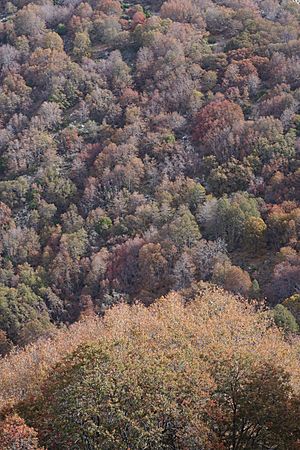Roble de Santiago facts for kids
Nothofagus macrocarpa, commonly known as roble de Santiago or Santiago's oak, is a special kind of tree. It's a deciduous tree, meaning its leaves fall off each year. This tree belongs to the Nothofagaceae family and grows only in the mountains of central Chile. It's considered a vulnerable species, meaning it needs protection.
Quick facts for kids Roble de Santiago |
|
|---|---|
 |
|
| A forest of Nothofagus macrocarpa trees on Cerro El Roble | |
| Conservation status | |
| Scientific classification | |
| Genus: |
Nothofagus
|
| Species: |
macrocarpa
|
| Synonyms | |
|
|
Contents
What Does Santiago's Oak Look Like?
The Nothofagus macrocarpa tree usually grows to be about 4 to 10 meters tall. That's like a two or three-story building! It often has a strong, thick trunk. Sometimes, two or three trunks grow from the same base.
Bark and Leaves
The bark of this tree is rough. It has a grayish-brown color with cracks running up and across it. The top part of the tree, called the crown, is full of leaves. It's very bushy and can spread out about 3 to 5 meters wide. The leaves are bright green and have wavy edges. They are usually oval-shaped. Each leaf is about 13 to 45 millimeters long and 7 to 23 millimeters wide.
Where Does Santiago's Oak Grow?
The Nothofagus macrocarpa tree lives in specific mountain areas of central Chile. You can find it at high places in the Altos de Cantillana. This area is in Melipilla Province, southwest of Santiago. Here, it grows at about 2,200 meters above sea level.
Other Locations
You can also find this tree further east. It grows in the Andes mountains near Cachapoal Province. In these foothills, it can be found at elevations from 500 to 2,000 meters.
Similar Trees
For a while, trees on Cerro El Roble and nearby mountains were thought to be N. macrocarpa. However, in the year 2000, scientists decided they were a different species. These trees are now called Nothofagus rutila.
How Scientists Classify Santiago's Oak
Scientists sometimes group Nothofagus macrocarpa as a type of Nothofagus obliqua. This means they see it as a special version or subspecies of that tree. In 2013, some scientists suggested a new name for it. They thought it should be called Lophozonia macrocarpa. This shows how scientists keep learning and updating how they classify living things.
See also
 In Spanish: Nothofagus macrocarpa para niños
In Spanish: Nothofagus macrocarpa para niños


